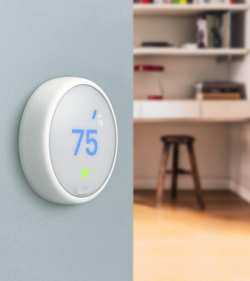It’s the beginning of a new year, the time when millions of Americans make resolutions to exercise more and eat less. For 2019, why not try something new? Include some energy efficiency resolutions to improve your home’s comfort and help keep the electric bill in check all year long.
The energy advisors at Walton EMC have compiled this list of five strategies homeowners should adopt to lower their energy bills. These tips are free or low-cost, and all can increase your energy savings.
1. Invest In A Smart Thermostat
 |
Nest's manufacturer claims its energy-saving features have saved users an average of 10 to 15 percent on heating bills and 15 on cooling bills. |
Wi-fi enabled “smart” thermostats were a hot holiday gift item in 2018 — and with good reason. Heating and cooling typically account for about half of an average home’s utility bills. Incorporating smart home technology into your HVAC system can add up to significant energy savings.
The manufacturer of Nest, one of the most popular smart thermostats on the market, claims its energy-saving features have saved users an average of 10 to 12 percent on heating bills and 15 percent on cooling bills. Using a programmable thermostat can save about $180 a year on household energy bills, according to the Environmental Protection Agency's Energy Star program.
Smart thermostats allow you to control the climate in your home remotely, as well as learn from your behaviors, show you energy consumption in real time, and even adjust themselves for conditions like extremely hot or humid days. A smart thermostat can be set to automatically turn off or reduce heating and cooling during the times when you are asleep or away.
LEARN MORE: Best smart home thermostats
2. Plug In to Advanced Power Strips
 |
An easy way to slay electricity-sucking vampires is to plug your electronics in to an advanced power strip. |
According to the Department of Energy (DOE), energy vampires — devices that use electricity even when they’re off — can add 10 percent to your utility bill. An easy way to slay these electricity-sucking vampires is to plug your electronics in to an advanced power strip (APS).
Though it looks like an ordinary power strip, an APS has built-in features that reduce the amount of energy used by many consumer electronics. There are several APS models on the market, but they all operate on the same basic principle of shutting off the supply power to devices that are not in use. Replacing a standard power strip with an APS can significantly reduce the amount of electricity consumed by home office and entertainment devices — and save money on your electric bill.
LEARN MORE: Identify the advanced power strip you need
3. Replace Old Bulbs
Replace your home’s incandescent bulbs with light-emitting diodes (LEDs). Quality LEDs use at least 75 percent less energy, and last 25 times longer, than standard incandescent bulbs. Though prices are dropping, LEDs still cost more than their traditional counterparts, but over their lifetime they can save you $80 or more in energy expenses. When shopping for LEDs, be sure to only buy those displaying the Energy Star logo. These bulbs meet specific requirements to ensure their energy efficiency and performance.
LEARN MORE: LED Lighting
4. Hack Your Heater
Water heaters account for about 12 percent of an average home’s energy use, consuming more energy than all other home appliances put together. Most home hot water heaters come preprogrammed to run at 140 degrees Fahrenheit, which is hotter than you need it for your bath or sink. Turning down the temperature on your water heater from 140 degrees Fahrenheit to 120 degrees can save you as much as 22 percent on your energy bill. Another hack: Ensure there is proper insulation around your heater so it's not pulling double duty.
5. Make A Schedule — Then Follow It
Dirt and neglect are one of the leading causes of heating and cooling systems failing, yet such failure is completely avoidable. At the very least, a dirty filter will slow down air flow, making your system work harder to keep you comfortable and costing you more money.
Despite the simplicity of the task, most of us are guilty of not checking our filters regularly. Here’s an easy fix: While noting birthdays, vacation dates and appointments on your 2019 calendar, specify a date each month to check your filter. Some filters have a 90-day life while others are only 30, but all should be checked every month and changed as needed. If you have pets or high traffic near the filter, you’ll probably end up changing it once a month. Also, note a few dates a year to order filters so you’ll have them on hand when needed.
Checking your air filter’s condition regularly will help to ensure the longevity of your system — saving you thousands in possible repair and replacement costs. Also, keeping your air filter clean and in good condition could save you up to 15 percent on electricity costs.
This year, resolve to try one or more of these tips for improving your home’s energy efficiency, and start seeing savings on your next electric bill.